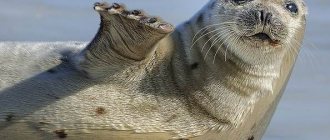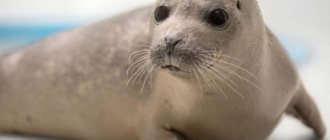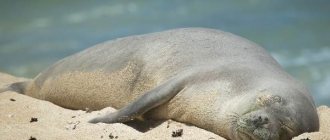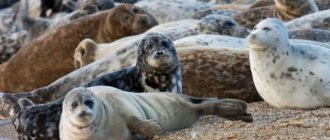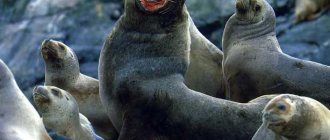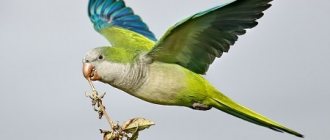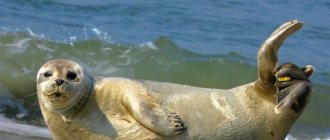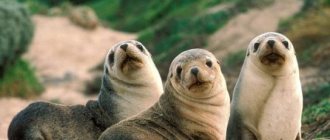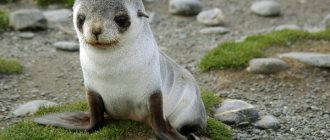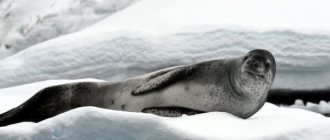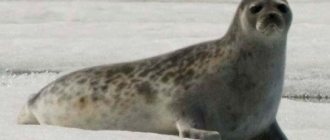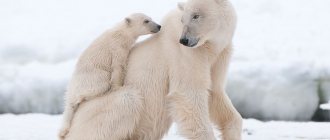Order Pinnipeds
| Order Pinnipeds (Pinnipedia) In a special direction there was specialization in another group of four-legged animals - in the order Pinnipeds, the most characteristic representatives of which are the so-called true seals, among a dozen species common in the seas washing the shores of the USSR, and in some of our inland... |
| Whales and Seals Although tropical waters are home to magnificent vegetation and colorful coral reefs, the blue waters of the open ocean in the tropics tend to be nutrient-poor and therefore almost lifeless. Due to the lack of plankton, there are few fish in them... |
| Seal and other pinnipeds Most likely, earlier, when asked which large animals are the most numerous on Earth, we would have answered antelopes. However, their time has long passed, and the herds of African antelope have noticeably thinned out. As for aquatic mammals, it is unlikely that anyone will remember them. |
| Monk seal, or white-bellied seal (Monachus schauinslandi) The monk seal, or white-bellied seal, is one of the rarest species of pinnipeds. All three species of this genus, as inhabitants of warm seas, the coasts of which have long been inhabited by people, have experienced strong human influence. One species of Caribbean monk seal lived off the coast and islands of the Caribbean... |
| Hohlach (Cystophora crfstata) One of the largest representatives of the family of true seals. Males are noticeably larger than females. The body length of males is about 240 cm, and the length of individual animals can reach 280 cm. The weight of males is from 260 to 300 kg, in exceptional cases - up to 375 kg. |
| Sea hare, or bearded seal (Erignatus barbatus) One of the large representatives of the subfamily. The body length (measured in a straight line) of males and females from the Atlantic Ocean basin is on average 222 cm. The average body length of males from the Pacific Ocean basin is 225, females - 217 cm; average weight 220-280 kg, can reach 360 kg. |
| Steller sea lion (Eumetopias jubatus) The body length of the male is on average 1 m longer than the body length of the female. The size of males is 320-330 cm, weight 700-800 kg, females - about 230 cm with a weight of up to 320 kg. The muzzle is wide and blunt with an upturned nose. The length of the thick labial vibrissae reaches 60 cm in males and 30 cm in females. |
| Long-faced or gray seal (Halichoerus grypus) A large representative of real seals, body length 2-2.5 m, the length of the largest specimens reaches 3 m. The total weight ranges from 150 to 300 kg or more. The body is massive, the head has an elongated facial part, the height of the muzzle is almost the same from the braincase to the front... |
| Striped seal, or lionfish (Histriophoca fasciata) Body length 155-165 cm, average weight about 55 kg. Males are larger than females. The body is slender, elongated. The neck is relatively long, the cervical interception is clearly visible. Vibrissae with a wavy surface. Males have a well-developed paired air sac... |
| Leopard seal (Hydrurga leptonyx) The largest of the Antarctic seals of this subfamily: body length more than 350 cm, weight more than 400 kg. The body is slender, relatively long with a large head resembling the head of a snake sitting on a long neck. The body length of newborns is 150-160 cm. They are covered with soft… |
Pages
1 |
|
Protection of Caspian seals
In Russia, the issue of suppressing and reducing human influence on reducing the population size of this species is currently being addressed at the legislative level. A decision was put forward to include the Caspian seal in the Red Book of the Russian Federation and strictly ban hunting. Today, attempts are being made to minimize the pollution of the waters of the Caspian Sea with waste from the oil and gas processing industries.
What actions are being taken to protect the species from human impact:
- Creation of protected habitat areas for Caspian seals;
- Analysis of water pollution in the Caspian Sea and reduction of harmful factors contributing to this;
- Preventing and preventing the capture of animals and cubs for carrying out all kinds of research until the population is restored;
- Creation of specialized nurseries, national parks, where zoologists, scientists and researchers will create favorable conditions for increasing the number of species;
- Development and implementation of international projects for the protection of this species of predatory mammals.
The Caspian seal is an amazing and very beautiful animal. However, soon it may completely disappear from the face of the earth. As a result of negligent attitude towards natural resources and wildlife, a person can destroy another unique representative of flora and fauna
Therefore, it is very important to make every effort to preserve and restore its numbers.
Video
Sources
- https://ecologynow.ru/knowledge/kaspiiskii-tulen-vymiranie-i-zanesenie-v-krasnuu-kniguhttps://wildfauna.ru/kaspijskaya-nerpahttps://fb.ru/article/246933/kaspiyskiy-tyulen- opisanie-jivotnogohttps://animalssea.ru/mlekopitajushhie/nerpy/nerpy.shtmlhttps://www.zooschool.ru/wild/pinnipedia/15.shtml
Elephant seals
(Mirounga) are the largest animals not only among true seals, but also among all pinnipeds, including the walrus. The length of an adult male is often 5.5 m (sometimes up to 6.7 m) with a weight of up to 3.5 tons. Females are smaller, about 3 m long. Elephant seals have rough, wrinkled skin, covered with short and sparse brown hair. When an animal sheds, the top layer of skin swells with bubbles and comes off in long strips along with the fur. The end of the male's muzzle is extended into a kind of trunk made of spongy tissue, usually hanging down in the form of a bag. During the mating season, the elephant seal greatly inflates it, and then forcefully releases the air outward: in this case, the trunk acts as a resonating chamber, and the roar of the animal is heard within a radius of several kilometers.
Animals swim rhythmically, quickly and even gracefully. They can dive deep in search of food; They feed on fish, including sharks, mollusks, crustaceans, and algae. The animal's stomach contains pebbles that help break down food. In the spring, elephant seals gather on the shore in colonies. Between February and June, the females move away from the herd and give birth to one young at a time, covered with black fur, in secluded places. On the shore, the elephant seal sleeps a lot and basks in the hot sun
If you wake him carelessly, he throws sand and small stones at the offender with his front flippers
Elephant seals are divided into two species. Northern elephant seals (M. angustirostris) have been common off the coast of California and Mexico in the past. Its herds numbered thousands of individuals, but between 1855 and 1870 they were so actively hunted for fat that the species was brought to the brink of extinction. Currently, the number of elephant seals is growing.
The southern elephant seal (M. leonina) has a circumpolar distribution in sub-Antarctic waters. It migrates regularly, going far into the open ocean and changing feeding areas depending on the time of year. During the breeding season, it reaches the north of the islands of South Georgia and Lobos in the South Atlantic Ocean.
Nutrition
- The diet of the individuals in question mainly consists of fish. In this case, the seals do not give priority to any particular species. Therefore, the animal is content with the catch that one or another was able to catch. However, to maintain a large body mass, seals prefer to hunt large fish.
- Such animals sometimes get very lucky when they come across huge schools of important fish. It often happens that schools of unprofitable fish tend to come close to the shore in numbers that suit the individuals in question. In this case, the seals can pursue their prey vira along the river.
- For example, if you take a closer look at seals’ relatives, seal seals, with the onset of summer such animals begin to feed on fish, which descend into the seas behind various river tributaries. After this, the individuals try to mainly eat capelin. It is this kind of fish that most often swims to the shore to die and does not get up during spawning time.
- Every year, seals also hunt en masse on top of salmon and herring. Only during the warm period can the individuals in question taste such fish. In any case, both herring and salmon tend to the shores to spawn. It is worth noting that it is during the cold season of summer that seals have a much more difficult time.
- The animals presented have to move away from the shores from time to time. They try to be stored nearby on drifting ice floes. In this case, the basis of nutrition can be provided by mollusks, pollock and octopuses. In any case, if the seal notices other fish, the alcohol will definitely not swim past it.
Hawaiian monk seal / Monachus schauinslandi
History of the study The Hawaiian monk seal (lat. Monachus schauinslandi) is a representative of the monk seal genus (Monachus), of the seal family (Phocidae).
Appearance Body length is approximately 225 cm. The color of adult males is dark brown or dark gray-brown on the back, with a white or yellowish-white tint on the belly. Females are lighter in color and usually larger than males.
Distribution The Hawaiian monk seal is an endemic species of the Hawaiian Islands. The bulk of the population is concentrated within the northwestern part of the archipelago. Rocky ledges near the coasts are the main habitat of the species.
Reproduction Females reach sexual maturity at the age of 4-8 years. Births occur throughout the year, with the largest number of cubs appearing in March and early April. Puppies are born covered with long black fur, weighing 14-17 kg. Breastfeeding lasts about 5-6 weeks. Life expectancy is 20-25 years.
Lifestyle However, Hawaiian monk seals spend two-thirds of their lives at sea. These marine mammals can often be found in the vicinity of coral reefs, where they are attracted by the abundance of tasty and affordable food. Recent studies have shown that monk seals are capable of descending to depths of up to 300 m. Like all of its relatives, the Hawaiian monk seal spends a lot of time in the ocean, foraging for food, and comes ashore to rest and gain strength. Monk seals received such a specific name because of their commitment to a solitary lifestyle. Relaxing on the shore or swimming in the vastness of the ocean, they prefer the loneliness of a large close company, choosing the most remote areas hidden from prying eyes. Even when they get together on land, they usually do not touch each other's bodies. But at the same time, during the long breeding season, he is quite social. Physical contact occurs only between males and females during the mating season and between mother and baby. Unlike other representatives of the order, which can lie “on top of each other” in large rookeries, monk seals try to stay apart.
Diet The main diet of Hawaiian monk seals, like other members of their family, includes various reef fish and cephalopods, which seals often hunt in small groups.
Population The population of Hawaiian monk seals is in a state of concern. The main threat is the reduction in food supply caused by active fishing and getting caught in fishing nets. Also, females and young seals often become victims of attacks by adult males.
Links[edit]
- ^ ab Littnan, C.; Harting, A.; Baker, J. (2015). " Neomonachus schauinslandi
".
IUCN Red List of Threatened Species
.
2015
: e.T13654A45227978. DOI: 10.2305/IUCN.UK.2015-2.RLTS.T13654A45227978.en .CS1 maint: uses authors parameter (link) - "Hawaiian monk seal, Monachus schauinslandi". monachus-guardian.org
. 2006. Retrieved May 23, 2011. - ^ abcde "Hawaiian monk seal (Monachus schauinslandi)". NOAA Fisheries Office of Protected Resources
. Retrieved March 11, 2011. - Nitta, Eugene; Henderson Jr. (1993). "Overview of interactions between Hawaii's fisheries and protected species" (PDF). Marine Fisheries Review
.
83.55
(2) . Retrieved May 23, 2011. - ^ abc "Monk Seal: Population and Threats". Pacific Islands Regional Office, NOAA Fisheries, Department of Commerce
. Retrieved February 17, 2022. - Rihanna
Solomon, Molly (January 25, 2022).
"Hawaiian monk seal population is on the rise". hpr2.org
. Honolulu, Hawaii: Hawaii Public Radio. Retrieved June 11, 2022. - ^ab Boland, R; Donoghue, R. (2003). "Accumulation of marine debris in the coastal marine habitat of the endangered Hawaiian monk seal, Monachus Schauinslandi." Marine Pollution Bulletin
.
11. 46
(11): 1385–139. DOI: 10.1016/S0025-326X(03)00291-1. PMID 14607537. - ^ B s d e f Schultz, J JK; Baker J; Toonen R; Bowen B. (2009). "Extremely low genetic diversity in endangered Hawaiian monk seals (Monachus Schauinslandi)". Journal of Heredity
.
1. 100
(1): 25–33. DOI: 10.1093/jhered/esn077. PMID 18815116. - ^ a b Schultz, J; Baker J; Toonen R; Bowen B. (2011). "The broad spectrum of genetic connectivity of the Hawaiian monk seal and implications for translocation." Conservation Biology
.
1. 25
(1): 124–132. DOI: 10.1111/j.1523-1739.2010.01615.x. PMID 21166713. - Reeves, R.R.; Stevert, B.S. (2002). The National Audubon Society's Guide to the World's Marine Mammals. ISBN 978-0-375-41141-0.
- Hawaii State Legislature. “Haw. Rev. Stat. § 5-12.5 (State Mammal)." Retrieved November 7, 2014.
- ^ abcd Goodman-Lowe, G. D. (1998). "Diet of the Hawaiian monk seal (Monachus Schauinslandi) from the northwestern Hawaiian Islands between 1991 and 1994" (PDF). Marine Biology
.
3. 132
(3): 535–46. DOI: 10.1007/s002270050419. Retrieved May 23, 2011. - ^ abc Baker, J; Yohanos, Thea K. (2004). "Abundance of Hawaiian monk seals on the main Hawaiian Islands." Biological conservation
.
1. 116
: 103–10. DOI: 10.1016/S0006-3207(03)00181-2. - Gilmartin, William; Forcada, J. (2002). Encyclopedia of Marine Mammals (ed.). Monk seals
. pp. 756–759. - ^ ab Kenyon, kW; Rice, D. W. (July 1959). "Life History of the Hawaiian Monk Seal". Pacific Science
.
13
. Retrieved May 23, 2011. - Perrin, William F.; Bernd Wursig; J. G. M. Thewissen (2008). Encyclopedia of Marine Mammals. Academic press. item 741. ISBN 978-0-12-373553-9.
- Repenning, California; Ray, C. E. (1977). "The Origin of the Hawaiian Monk Seal". Proc. Biol. Soc. Wash
.
89
: 667–688. - "Historical Timeline of the Hawaiian Monk Seal" (PDF). National Marine Fisheries Service , Pacific Islands Regional Office
. Honolulu, Hawaii, USA. June 29, 2011. Retrieved November 19, 2012. - Bertha, Annalisa; Sumich, James L (1999). Marine mammals
.
Evolutionary Biology
. Academic press. ISBN 978-0-12-093225-2. - Parrish, F.A.; Littnan, C. L. (2008). "Changing Perspectives in Hawaiian Monk Seal Research Using Animal Imagery" (PDF). Journal of the Marine Technology Society
.
41
(4): 30–34. DOI: 10.4031/002533207787441944. Retrieved May 23, 2011. - Jump up
↑ Parrish, Frank A (1999). In: Hamilton RW, Pence DF; Kesling DE Assessment; Possibility of carrying out technical diving work for scientific research (ed.). Using technical diving to survey the feeding habitat of the endangered Hawaiian monk seal. American Academy of Underwater Sciences. Retrieved May 23, 2011. - "Hawaiian Monk Seal". NOAA Fisheries
. Retrieved November 26, 2022. - Bertilsson-Friedman, P (2006). "Distribution and frequency of shark injuries to the endangered Hawaiian monk seal ( Monachus Schauinslandi
)."
Journal of Zoology
.
268
(4):361–68. DOI: 10.1111/j.1469-7998.2006.00066.x. - "Hawaiian Monk Seal". National Wildlife Federation
. Retrieved July 7, 2015. - ^ ab Ellis, Richard (2004). No Turning Back: The Life and Death of Animal Species. New York: Harper Perennial. paragraph 195. ISBN 978-0-06-055804-8.
- "Captive Care and Release Research Project Aims to Help Recover the Endangered Hawaiian Monk Seal". NOAA
. Retrieved May 23, 2011. - "Feds: Caribbean monk seal officially extinct". Fox News
. Associated Press. June 9, 2008. Retrieved May 23, 2011. - "Hawaiian monk seal population at a glance". noaa.gov
. Honolulu, Hawaii, USA. Retrieved November 24, 2012. - "Hawaiian Monk Seal". [Seal Conservation Society]
. Killyleagh, County Down, Northern Ireland, UK and Kingsbarns, St Andrews, Scotland, UK. August 2011. Retrieved November 24, 2012. - "Turtle Bay". MonkSealMania.blogspot.com
. 2012. Retrieved November 19, 2012. - ↑
Davis, Chelsea (29 June 2022).
"On rare occasion, a Hawaiian monk seal and her pup make Waikiki Beach their home". HawaiiNewsNow
. Retrieved June 29, 2022. - Wianecki, Shannon. "Hard Water Puppies". Maui Journal
. Archived from the original on July 23, 2011. Retrieved May 23, 2011. - Weber, Gretchen. "The fight for survival: Environmental threats threaten monk seals". PBS
. Retrieved May 23, 2011. - ^ B s d e g h i JK Antonelis, GA; and others. (2006). "Hawaiian monk seal (Monachus schauinslandi): status and conservation issues". Res Bull Atoll
.
543
: 75–101 (88–89). - ^ ab Exile, LD; Gilmartin, W. G. (1992). "Pathological Findings in the Hawaiian Monk Seal". Journal of Wildlife Diseases
.
28
(3):428–434. DOI: 10.7589/0090-3558-28.3.428. PMID 1512875. - ^a b Starfield, A.M.; Roth JD; Ralls K (1995). "Mobbing in Hawaiian monk seals: the value of simulation modeling in the absence of clearly relevant data." Canned Biol
.
9
(1): 166–174. DOI: 10.1046/j.1523-1739.1995.09010166.x. JSTOR 2386398. - "Hawaiian monk seals". earthtrust.org
. Archived from the original on May 15, 2011. Retrieved May 23, 2011. - ^ab Lowry, Lloyd (2011). "Recovery of the Hawaiian monk seal (Monachus schauinslandi): a review of conservation efforts, 1972–2010, and thoughts for the future" (PDF). Aquatic mammals
.
37
(3):397–419. DOI: 10.1578/AM.37.3.2011.397. - Honnold, IP, Brown, R, Scott, DP, Sreekumar, C, & Dubey, JP (2005). Toxoplasmosis in the Hawaiian monk seal (Monachus schauinslandi). Journal of Parasitology, 91(3), 695-697.
- Barbieri, M. M., Kashinsky, L., Rothstein, D. S., Colegrove, K. M., Aman, K. H., Magargal, S. L., … & Littnan, C. L. (2016). Protozoan-associated mortality in endangered Hawaiian monk seals Neomonachus schauinslandi. Diseases of Aquatic Organisms, 121(2), 85-95.
- ^ ab Ellis, Richard (2004). No Turning Back: The Life and Death of Animal Species. New York: Harper Perennial. paragraph 194. ISBN 978-0-06-055804-8.
- ^ abc Dawson, Teresa (7 December 2010). "New Threat to Hawaiian Monk Seals: Cat Parasite Carried by Sewage, Sewage - Environmental Health News". Environmental Health News: Front Page
. Archived from the original on January 21, 2015. Retrieved March 16, 2011. - "THE DEATH OF THE SEAL - USA: (HAWAII) TOXOPLASMOSIS UPDATE". Salon
. August 8, 2022 - By mail ProMED . - ^ ab "Second revision of the Hawaiian monk seal (Monachus schauinslandi) recovery plan" (PDF). National Marine Fisheries Service Pacific Island Fisheries Science Center , part of the National Oceanic and Atmospheric Administration
. Honolulu, Hawaii, USA. January 28, 2010 [2007]. Archived from the original (PDF) on October 6, 2006. Retrieved November 24, 2012. - "Hawaii Monk Seal Recovery Program". NOAA Fisheries Service Division of Protected Resources
. Retrieved November 24, 2012. - Please, Tracy (June 12, 2008). "The Hawaiian monk seal is the new state mammal". KHNL NBC 8 Honolulu, Hawaii
. Archived from the original on August 11, 2011. Retrieved May 23, 2011. - ^ab Gerrodette, Tim; Gilmartin William Gee (1980). "Demographic implications of site shifts in Hawaiian monk seal pups and sampling". Conservation Biology
.
4
(4): 423–430. DOI: 10.1111/j.1523-1739.1990.tb00317.x. JSTOR 2385936. - Aguirre, A.; T. Keefe; J. Reif; L. Kashinsky; P. Jochem (2007). "Infectious disease monitoring of the endangered Hawaiian monk seal". Journal of Wildlife Diseases
.
43
(2):229–241. DOI: 10.7589/0090-3558-43.2.229. PMID 17495307. - Hawaiian monk seal. US Fish and Wildlife Service.
- "Fisheries Service to Conduct Monk Seal Hearings". Maui News
. September 6, 2011
Sea lion
(Eumetopias jubata) is the largest of the eared seals. It was described by the German biologist G. Steller, who named the species the sea lion (Leo marinus): the males, with their massive neck and withers, relatively slender rear half of the body and golden eyes, reminded him of the king of beasts.
The color of sea lions is yellowish-brown; The body length of a large cleaver reaches 4 m, and its mass is a whole ton. However, in most cases they are no longer than 3 m and no heavier than 700 kg. Females are much smaller and have a lighter build; their body length is 2.5 m and their weight is approximately 350 kg.
In the spring and summer, sea lions breed on the northern coasts of the Pacific Ocean, including Alaska, and spend the winter months in the warm waters off the coast of Mexico. Their harems are small; with one male there are rarely more than 12 females. The weight of a newborn sea lion varies from 16 to 23 kg, depending on gender, and by two months they can weigh up to 45 kg. Babies are born sighted and very soon begin to quickly crawl over rocks, dodging huge adult animals that can accidentally crush them.
Appearance
Monk seals are characterized by the following features: a skull with widely spaced zygomatic arches (especially in older individuals) and a slightly expanded nasal region. The nasal processes of the premaxillary bones are usually not wedged between the nasal and maxillary bones. The anterior edge of the nasal bones forms two projections separated by a notch. The bony palate has an arched posterior margin with a median angular notch. Unlike other seals, monk seals have a powerfully developed posterior part of the lower jaw. There are large preorbital processes. The bony auditory tympani are small and triangular in shape. The bony auditory canal is not bent into a knee shape. The cheek teeth are closely adjacent to each other and, as a rule, do not have additional tips (if they are present, they are very small). All cheek teeth, except the first premolar, have two roots. The internal upper incisors have flattened roots. Hind flippers with a rather deep median notch and wide outer blades. The claws on them are very small. On the front flippers, the first finger is the longest, the rest gradually become smaller towards the fifth; claws are well developed and wide. The hairline is low, hard and smooth, lying close to the body. The vibrissae are smooth and oval in diameter. The color of the back is from dark gray to blackish-brown; lighter on the belly. There are 34 chromosomes in the diploid set. The body length of this species is 210-250 cm. Distribution In the waters of the Black Sea, the monk seal was found until the end of the last century as single individuals and small groups off the southwestern coast of Crimea. Currently, a small number of them live in the Black Sea off the coast of Bulgaria, where there are two very small herds breeding off Cape Kaliakra and south of Burgas. Occasionally, single individuals are found off the coast of Romania. Part of the Black Sea population lives in the coastal zone of Turkey, apparently mainly in the western regions. The rest of the range covers the Mediterranean Sea and the Atlantic coast of Africa to the south, apparently to the mouth of Senegal at about 15° N. w. Thus, small groups of monk seals have been preserved on the Greek island of Samos, in the Tyrrhenian Sea on the Italian island of Montecristo, on the Ilhas Desertas islands off Madeira, on the Tunisian islands of Galite and Zembra. Currently not found within the CIS. In the second half of the 19th century. monk seals were distributed along the western coast of the Black Sea, the Crimean shores, in the western part of the peninsula and along the southern coast of Crimea. Apparently, the finds on the southern coast of Crimea date back to the beginning of the last century. In the area of the Bear Caves near Sevastopol, behind the Chersonesos lighthouse, monk seals were still hunted at the end of the 19th century. All cases of modern sightings of monk seals along the southern part of the Caucasus coast are unreliable. From 1946 to 1951, there were several cases of monk seals being caught in fishing nets in the northern reaches of the Danube Delta. There are no enemies other than humans. The total number of the species by 1976 was estimated at approximately 1,000 heads. The number in the Black Sea is unknown, but is unlikely to exceed several dozen. Despite the fact that the monk seal is protected by law off the coast of Bulgaria, its number does not increase, and in the area of Cape Kaliakra it reaches 20-30 animals. The decline in numbers and complete disappearance of monk seals in the territory of the former USSR is mainly due to anthropogenic impact, including direct destruction by humans.
Lifestyle and nutrition
They stayed in the coastal zone near places sparsely populated by humans, rocky, heavily indented areas of the coast, or off the coast of rocky desert islands. They often found refuge in rock crevices and caves. They led a sedentary lifestyle and reproduced on the same section of the coast from year to year. Activity was mainly during the day. In the Black Sea it feeds mainly on flounder, and to a lesser extent on mackerel and anchovies. Social structure and reproduction Mating apparently occurred in the autumn or late summer. Pregnancy 10-11 months. Females gave birth to cubs at the end of summer - in the fall, once every one to two years. Lactation was 6-8 weeks. They began to reproduce, apparently, at the age of four years.
Western black rhinoceros
This subspecies of black rhinoceros was declared extinct just a couple of years ago. He became a victim of regular hunting in his habitat, in Cameroon. Rhinoceros horns, used in Chinese medicine to treat numerous diseases, were considered the most valuable to poachers. Scientists have been actively searching for surviving individuals of this species since 2006. However, since their search for five years was unsuccessful, the western black rhinoceros was declared extinct. Other species of black rhinoceros are also at risk of extinction. Year of complete disappearance: 2011
[region:bone:inline_2]
Appearance
Monk seals are characterized by the following features: a skull with widely spaced zygomatic arches (especially in older individuals) and a slightly expanded nasal region. The nasal processes of the premaxillary bones are usually not wedged between the nasal and maxillary bones. The anterior edge of the nasal bones forms two projections separated by a notch. The bony palate has an arched posterior margin with a median angular notch. Unlike other seals, monk seals have a powerfully developed posterior part of the lower jaw. There are large preorbital processes. The bony auditory tympani are small and triangular in shape. The bony auditory canal is not bent into a knee shape. The cheek teeth are closely adjacent to each other and, as a rule, do not have additional tips (if they are present, they are very small). All cheek teeth, except the first premolar, have two roots. The internal upper incisors have flattened roots. Hind flippers with a rather deep median notch and wide outer blades. The claws on them are very small. On the front flippers, the first finger is the longest, the rest gradually become smaller towards the fifth; claws are well developed and wide. The hairline is low, hard and smooth, lying close to the body. The vibrissae are smooth and oval in diameter. The color of the back is from dark gray to blackish-brown; lighter on the belly. There are 34 chromosomes in the diploid set. The body length of this species is 210-250 cm.
Description
- Monks have certain distinctive features. Their head has powerful cheekbones that are clearly visible. Especially among the older generation. The nose of animals is wide and spaced, standing out. The processes of the nasal region do not have the peculiarity of wedging between the bones of the upper jaw and the nasal bones. The anterior section of the nose has several projections, between which there is a hole.
- The palate is an arched area, which is equipped with an angular cutout. A distinctive feature of individuals of the variety under discussion is considered to be a powerful, developed lower jaw. Other species cannot boast of this feature. There are also processes in front of the eyes. The hearing aid is medium in size and has a triangle format.
- The passages in the hearing aid are straightened and do not bend at right angles. The teeth are pressed tightly against each other, they are the same in size, and have no protrusions. Almost every tooth in a row has several roots. As for the incisors, they are dense, with one root. The fins located at the back are deep, wide, and have cutouts. The claws are small and practically play no role.
- The front flippers are distinguished by the presence of a large and long curved toe. All the rest are gradually decreasing, the fifth one is even small. The claws are thick, sharp, wide, and help to climb onto hard surfaces.
- As for the fur, it is smooth and stiff, and has a water-repellent oily lubricant at the base. The fur fits tightly to the body. The mustache is smooth and long. The pigmentation of individuals of the presented variety is gray, dark, and can be brown-black. The abdominal section is highlighted. Along the body of the individual, monks stretch up to 2.4 m.
Striped seal or lionfish
(Histriophoca fasciata), a small animal, close in size to the common seal, but at the same time the most conspicuous of all pinnipeds. The color of the male is reddish-brown, almost black, with wide white rings around the neck, rump and bases of the front flippers; females are fawn-gray with a narrow stripe at the back. The length of the male is approximately 1.7 m, the female is approx. 1.5 m.
The range of the striped seal is small: the northern part of the Pacific Ocean, from the Aleutian to the Kuril Islands. Total number approx. 25,000 individuals. Very little is known about the lifestyle. Seals live in groups of several individuals, apparently in families.
Popularization
- Animals live in the Black Sea; there were plenty of them in these waters until the end of the last century. Individuals prefer to live in flocks rather than alone. They are found in Crimea until today, in the southwest. There are also many representatives of the family in the waters of Bulgaria; the local climatic conditions suit them. Reproduction takes place in Burgas and Kaliakra, the number is constantly increasing.
- It is painfully rare to find individuals of this genus in Romania; then they preferably live alone. Some of the seals are located in Turkey, the rest of the population is dispersed exactly along the shores of the Mediterranean Sea. Seals of this species like the African and Atlantic coasts. Some individuals still live on the island of Samos, one of which is located in Greece.
- Also, a small number of heads are found on the island of Montecristo, Italy. Of course, we cannot help but mention the presence of seals in Tunisia and on the island of Madeira. The latest head count showed that there are about 1.5 thousand heads of these seals. The indications are currently unknown. It is also unclear which part is located in Crimea.
- For example, off the coast of Bulgaria, the individuals in question are protected by law. It is disappointing that the number of such animals is not increasing. Adjacent to Cape Kaliara, the number of individuals is approximately 30 heads.
- In the territory of the former USSR, the number of seals began to shrink greatly, and then disappeared completely. This was mainly due to anthropogenic special effects. Among other things, several decades ago servants exterminated such animals en masse.
Sea lion
(Eumetopias jubata) is the largest of the eared seals. It was described by the German biologist G. Steller, who named the species the sea lion (Leo marinus): the males, with their massive neck and withers, relatively slender rear half of the body and golden eyes, reminded him of the king of beasts.
The color of sea lions is yellowish-brown; The body length of a large cleaver reaches 4 m, and its mass is a whole ton. However, in most cases they are no longer than 3 m and no heavier than 700 kg. Females are much smaller and have a lighter build; their body length is 2.5 m and their weight is approximately 350 kg.
In the spring and summer, sea lions breed on the northern coasts of the Pacific Ocean, including Alaska, and spend the winter months in the warm waters off the coast of Mexico. Their harems are small; with one male there are rarely more than 12 females. The weight of a newborn sea lion varies from 16 to 23 kg, depending on gender, and by two months they can weigh up to 45 kg. Babies are born sighted and very soon begin to quickly crawl over rocks, dodging huge adult animals that can accidentally crush them.
Spreading
In the waters of the Black Sea, the monk seal was found until the end of the last century as single individuals and small groups off the southwestern coast of Crimea. Currently, a small number of them live in the Black Sea off the coast of Bulgaria, where there are two very small herds breeding off Cape Kaliakra and south of Burgas. Occasionally, single individuals are found off the coast of Romania. Part of the Black Sea population lives in the coastal zone of Turkey, apparently mainly in the western regions. The rest of the range covers the Mediterranean Sea and the Atlantic coast of Africa to the south, apparently to the mouth of Senegal at about 15° N. w. Thus, small groups of monk seals have been preserved on the Greek island of Samos, in the Tyrrhenian Sea on the Italian island of Montecristo, on the Ilhas Desertas islands off Madeira, on the Tunisian islands of Galite and Zembra.
Currently not found within the CIS. In the second half of the 19th century, monk seals were distributed along the western coast of the Black Sea, the Crimean shores, in the western part of the peninsula and along the southern coast of Crimea. Apparently, the finds on the southern coast of Crimea date back to the beginning of the last century. All cases of modern sightings of monk seals along the southern part of the Caucasus coast are unreliable. From 1946 to 1951, there were several cases of monk seals being caught in fishing nets in the northern reaches of the Danube Delta.
The species is included in Appendix II of the Berne Convention, Appendix II of the Bonn Convention and Appendix I of the International Convention CITES. There remains a possibility of recolonization by the Black Sea species, including its return to the shores of Crimea, subject to the preservation of existing potentially suitable habitats on the coasts of the Opuksky Nature Reserve and the Tarkhankutsky National Natural Park.
There are no enemies other than humans.
The total number of the species by 1976 was estimated at approximately 1,000 heads. The number in the Black Sea is unknown, but it is unlikely to exceed several dozen. Despite the fact that the monk seal is protected by law off the coast of Bulgaria, its number does not increase, and in the area of Cape Kaliakra it reaches 20-30 animals. The decline in numbers and complete disappearance of monk seals in the territory of the former USSR is mainly due to anthropogenic impact, including direct destruction by humans.
Javan tiger, 1994
Another species that has lost its habitat due to agricultural expansion. Javan tigers were found on the Indonesian island of Java. The last place they were seen alive was the highest mountain in Java. From 1984 to 1993, scientists could not find any evidence of the existence of the subspecies and it was declared extinct.
Representatives of the order Pinnipeds
In the group of pinnipeds, there are currently 33 species in three families: true (or earless) seals, sea lions (or eared seals) and walruses.
Real seals
The family Phocidae includes 18 species of seals and seals. Representatives of this family are easy to distinguish: their hind limbs (flippers) do not bend to the body and do not participate in terrestrial movement, as well as in movement on ice. Clumsy on land, true seals are very agile in the water. They also lack ears. In addition, all true seals have a thick layer of subcutaneous fat.
A Weddell seal basks on a rocky island. This most southerly of all seal species has the long, wide flippers characteristic of all southern true seals.
Eared seals
The eared seal family (Otariidae) includes nine species of fur seals and five species of sea lions.
Unlike real seals, the hind limbs of eared seals bend freely under the body and facilitate the movement of animals on a hard substrate; at the same time, they are less suited for swimming.
Representatives of the order Pinnipeds are sea lions (male and female). All species are sexually dimorphic: males are larger (and darker) than females
Eared seals retain a rudimentary auricle supported by cartilage. Their hair coat is usually thicker than that of their true relatives, and consists of numerous long guard hairs and an underlying dense undercoat.
The fur of representatives of this family has water-repellent properties and retains a layer of air between the hairs, which contributes to better thermal insulation. Their layer of blubber is usually thinner than that of real seals.
On the front flippers of seals and walruses, the claws are poorly developed, in contrast to the limbs of seals, which are armed with strong, well-developed claws. In the aquatic environment, animals move using lateral strokes and oscillations of the hind limbs, while the front flippers serve as rudders.
Walruses
The family Odobenidae includes one species - the walrus. This representative of the pinniped order combines the features of true and eared seals.
The walrus has triangular flippers (like those of real seals) and can tuck them forward (like eared ones).
Female walrus with calf
Like real seals, the walrus does not have an ear. However, unlike all other pinnipeds, this species has virtually no fur, reduced to individual hairs scattered throughout the body.
Both males and females have elongated fangs (tusks).
Where does the Caspian seal live?
The animals got their name due to their habitat. They live exclusively on the territory of the Caspian Sea from Iran itself to the Caspian Sea. The southern coast of the Caspian Sea has virtually no seal populations.
Caspian seals migrate to other territories every season. With the beginning of the winter season, all animals move to the glaciers of the northern region of the Caspian Sea. At the end of winter and the onset of a warmer season, glaciers gradually decrease in size and melt.
Then the animals move to the territory of the middle and southern coast of the Caspian Sea. There is a sufficient amount of food supply here, which allows you to accumulate a sufficient amount of subcutaneous fat, which will help you survive the harsh, sometimes hungry winter.
In the warm season, the Caspian seal often finds itself at the mouth of the Volga and Ural. Animals can often be seen drifting freely on isolated, large ice floes. The researchers noted that in winter most of the time animals are in the water, and in the warm season, on the contrary, they mainly live on land.
Northern fur seal
(Callorhinus ursinus) is famous for its magnificent soft and durable fur. The body length of an adult male (cleaver) is up to 2 m, weight more than 300 kg; the color is dark, chocolate brown, sometimes almost black, with grayish shoulders and neck. Females are smaller and more graceful, no more than 1.2 m long; their neck is long and thin, their fur is grayish. It consists of an outer layer of long, shiny guard hairs covering a thick, soft undercoat.
The northern fur seal is a herd animal. It feeds mainly on schooling fish (primarily herring) and squid. The lifestyle is conservative, subject to a strict “schedule”. During winter migrations in the Pacific Ocean, herds of these animals, heading south, swim almost 1000 km and reach the latitudes of California. In the spring they return to the islands in the Bering and Okhotsk seas, where they reproduce. Choppers are the first to appear at rookeries in April-May, choosing better places and defending them in fights with their fellows. Each individual site occupies a strip of beach 25–30 m long. Weaker (“haremless”) males have to be content with places located further from the shore and wait there for a random female. Young males not allowed to mate form their own small groups. Mature pregnant females (queens) arrive on the islands between mid-June and mid-July. On the shore, each of them is met by the male who happens to be closest to the others and takes them to his area. The female gives birth to one calf, usually a few hours after arrival, a maximum of two days.
A very large, strong billcutter may have up to 100 females in its “harem,” but usually there are 40–50. To maintain it, the male has to remain nearby all the time, going without food for at least two months, and often much longer. The cleaver “does not trust” either his partners or his neighbors and stands on duty day and night, constantly declaring his rights to those around him with a deafening roar. By the beginning of August, all females that have already given birth are covered again. Exhausted and emaciated from the hunger strike, the cleavers return to the sea and feed there with their brothers. But the mating season is not over yet. At this time, thousands of virgin two-year-old females arrive on the coast for the first mating.
The cubs, covered with shiny blackish-brown fur, are born sighted. At 6–8 weeks of age they begin to swim. The mother feeds them for 4 months, until the start of winter migration. Only a few babies reach puberty; About half of them are eaten by sharks and killer whales in the first year of life.
Evolution and migration
Nerpa on Laysan Island
Monk seals are members of the family Phocidae. In an influential 1977 paper, Repenning and Ray suggested, based on some unspecialized characteristics, that they were the most primitive seals alive. However, this idea has since been completely scrapped.
In an effort to educate the public and conserve seals, the National Oceanic Atmospheric Administration (NOAA) Fisheries Service has developed a historical timeline to demonstrate that the Hawaiian Islands have been home to seals for millions of years and that the seals belong to them. Evidence points to the migration of monk seals to Hawaii between 4–11 million years ago (Ma) through an open waterway between North and South America called the Central American Seaway. The Isthmus of Panama closed the channel about 3 million years ago.
Bertha and Sumich ask how this species got to the Hawaiian Islands when its closest relatives are on the other side of the world in the North Atlantic and Mediterranean Sea. The species may have evolved in the Pacific or Atlantic, but in any case came to Hawaii long before the first Polynesians arrived.
Monk seals
(Monachus) – medium size; The length of the male is up to 2.5 m. The color ranges from dark brown to grayish-brown. They live in warm seas, where competition with other seals is minimal. Animals live in small family groups or colonies. Newborn cubs are covered with long and soft blackish fur.
The Caribbean or tropical monk seal (M. tropicalis) used to be common in the West Indies. Now he is close to extinction. The Mediterranean monk seal (M. monachus) is still quite common in the Mediterranean, Black and Adriatic Seas, and around Madeira, the Canary Islands and other islands off the west coast of Africa. The Hawaiian monk seal (M. schauinslandi) lives in the western part of the Hawaiian archipelago.
Lifestyle and nutrition
The ecology is similar to that of the monk seal. They feed on various reef and bottom fish, as well as cephalopods.
